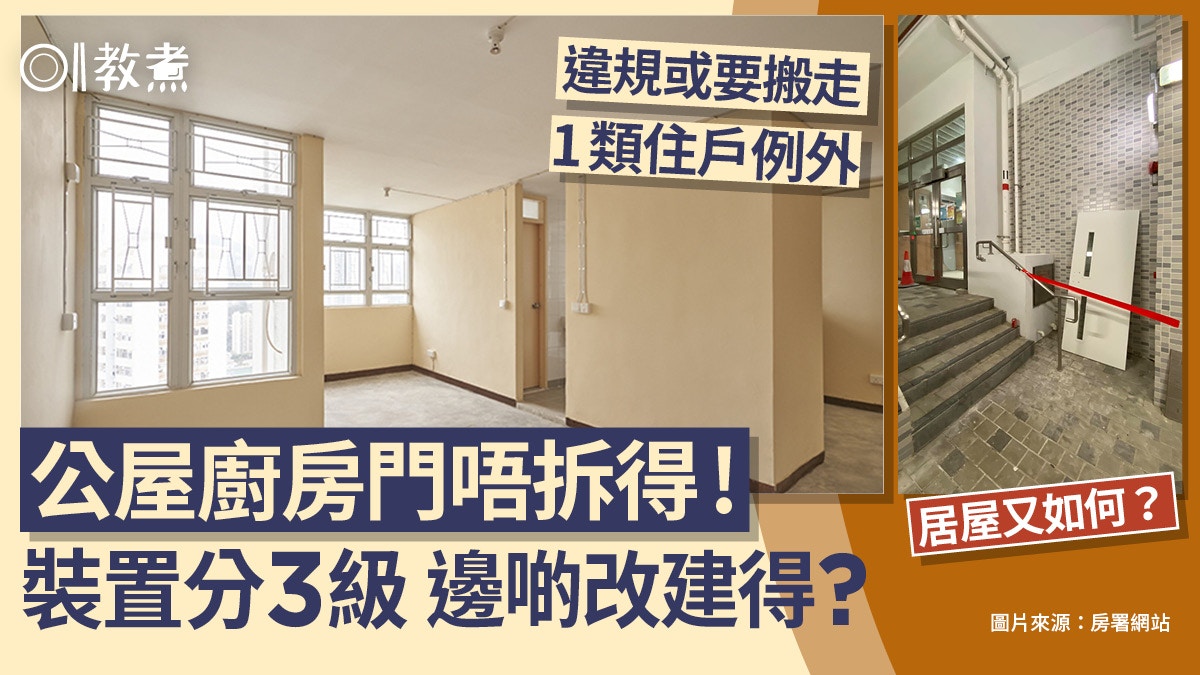Public housing units are not large, and in order to save space, many people choose to remove the kitchen door or wall and replace it with an open or semi-open kitchen, so that the unit area looks larger and can make more use of space. Some people may also be concerned about the privacy of public housing, so they change the door locks to electronic locks. Many people think that it is enough to restore everything at their own expense when the housing department recycles the flat or the tenant moves away, but in fact, the original actions such as tearing down the wall and demolishing the kitchen door have violated the terms of the public housing tenancy agreement.
As at the end of March 2023, the "comprehensive waiting time for public housing" for ordinary applicants for public housing is 3.5 years. (Profile picture)
Public Housing Type 3 fixtures Class A No changes are allowed for Class 1 persons, with exceptions
According to the Housing Department, the PRH flats allocated by the Housing Department to tenants generally provide various fixtures and equipment. Fixed devices are divided into three categories: A, B and C. Category A is a fixed device that cannot be changed at its own expense; Category B requires prior approval from the HA before making changes at its own expense; Category C is subject to change at the HA's own expense without prior approval.
Category A: lattice walls between kitchens, toilets or bathrooms; Fire doors, frames and hardware (doors and kitchen doors); soundproof windows (including acoustic panels); Power supply wires, etc. belong to Category A, that is, fixed devices that cannot be changed at their own expense.
Type B: alteration of existing non-structural interior walls other than kitchens, toilets or bathrooms; Non-insulated doors, frames and hinges; Stove; wash basins; Anti-theft iron gates and locks belong to Class B fixed devices.
Class C: indoor oil color; Floor surface materials; kitchen cupboards, cabinets; Mailbox locks; Shower heads, faucets, etc. belong to Class C fixtures.
In other words, PRH tenants are required to obtain prior permission from the Housing Department when changing the anti-theft gates and locks; The kitchen fire door and its partition wall cannot be removed by any person, and if the estate office finds that the tenant has made illegal changes in the flat, the tenant must correct or restore it at his own expense. If the tenant fails to cooperate with the restoration works, the HA will take tenancy control actions, including issuing an eviction notice to terminate the tenancy agreement of the flat. However, the Guidelines also provide that applications for modification of Class A fixtures submitted by persons with disabilities may be considered.
Public housing door with chip A sweep will know who is abandoned
Residents of Queen Hill Estate once abandoned kitchen fire doors, and security guards said that they could know which unit was abandoned by scanning the chip with an instrument. (Profile picture)
Since mid-2012, the HA has installed chips with radio frequency identification technology (RFID) in all new tenders for public housing projects, including precast concrete facades, aluminium windows, wooden doors and iron gates, to record information such as production capital, model batch, factory location, date and installation location of the components. If it is found that Class A fixtures such as kitchen doors and gates have been dismantled and discarded, the Housing Department personnel can use the instrument to read the information of the unit to which they belong and request the tenant to restore it.
Public housing|The kitchen door of Queen Hill Estate was demolished and abandoned Security guard said that he used the chip to find the "real murderer" to cause heated discussion about public housing chips|New public housing Haida Estate gate and kitchen door suspected of built-in chips to prevent tenants from demolishing and restoring public housing without authorization? Have renovated kitchen toilets Netizens share housing price list The correct procedure is the right one
HOS kitchen doors can be demolished, but conversion to an open kitchen must be applied
HOS tenants will be issued a HOS Renovation Guide providing HOS Renovation Restrictions and Precautions before moving in. HOS flats have more freedom in the interval between installation and modification, and will not be subject to the same regulation and supervision as PRH tenants, but there are relatively restrictions.
HOS flats also need to follow the deed of mutual covenant of the building, such as changing the aluminium windows, etc., it is a violation of the deed of mutual covenant of the building; Installations involving structural hazards (e.g. main walls, beams) should also not be removed. However, the kitchen doors, worktops and toilet doors of HOS flats can be dismantled, but if the wall demolition works are required, the consent of the Buildings Department is obtained, and if you wish to convert the terrier kitchen into an open kitchen, you must apply to the Buildings Department for Access, and you must also add suitable fire protection equipment in accordance with the Fire Services Ordinance and cannot be modified by yourself.
Kitchen decoration|3 major fallacies in open kitchens, can you cook food over an open fire?
Can the kitchen fire doors of public housing be removed at my own expense?
Kitchen fire doors in public housing are Class A fixtures that cannot be changed at their own expense and are contrary to the terms of the public housing tenancy agreement, although there are Type 1 PRH tenants who may be exempted.
Are the decoration guidelines for public housing and HOS flats the same?
HOS flats have greater freedom in the interval between installation and modification and will not be subject to the same regulation and supervision as PRH tenants. Kitchen doors, worktops and toilet doors can be removed, but HOS structural buildings cannot be removed.
